Jean Dufresne (14-02-1829 - 13-04-1893) chess player, composer and author
He is known for the
Evergreen game with Adolf Anderssen, whose student he was and for his "
Kleines Lehrbuch des Schachspiels" (1881). What's he doing here?, you may righteously ask. Dufresne also composed some studies, of which you can find a sample below. Our readers will enjoy his anthology published in the end of the 19th century and kindly hosted by
Anders Thulin:
"
Sammlung leichterer Schachaufgaben, I" (1881)
"
Sammlung leichterer Schachaufgaben, II" (1882)
"
Sammlung leichterer Schachaufgaben, III" (1887)
An easy study:
Dufresne, Jean
bs53-521, 1910

Show Solution1. b7 a2 2. b8=Q a1=Q+ 3. Qe5+ Qxe5+ 4. fxe5 and nothing can save Black.
Jiří Kauder (14-02-1887 - 1940?) Czech composer
Kauder was a good chess player, a prominent chess official and organizer. Of course he composed in the suave Bohemian style.
More about his chess career can be read in
this book. He died martyred by the Nazis during the German occupation.
Kauder, Jiří
1471 Cesky denik, 1940
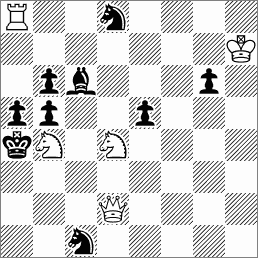
Show Solution
1.Sa6 ! (2.Qb4+ axb4 3.Sc5#)
1...Ka3 2.Qxc1+ Ka4, Ka2 3.Qa1, Sb4#
1...Bxa8 2.Qc2+ Sb3, Ka3 3.Qxb3/Qa2, Sxb5#
Wielgos, Oskar
Deutsche Schachblätter, 1977
1
st Prize
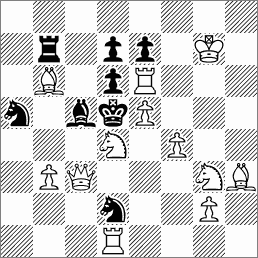
Show SolutionSet play:
1...dxe6[a] 2.Bxe6#[A]
1...dxe5[b] 2.Qxc5#[C]
1...Sf1/Sf3/Sdc4/Sb1 2.Qf3#[B]
Tries:
1.Rxd2? (2.Qf3#[B])
1...dxe5[b] 2.Qxc5#[C]
1...Sxb3 2.Qxb3#
but 1...Bxb6!
1.Sc2? (2.Qf3#[B])
1...dxe5[b] 2.Qxc5#[C]/Qxe5#[D]
1...Kc6 2.Qxc5#[C]
1...Bd4/Bxb6 2.Sb4#
1...Be3 2.Sxe3#/Sb4#
but 1...Sxb3!
1.Sc6? (2.Sxe7#[E]/Qf3#[B])
1...dxe6[a] 2.Qf3#[B]
1...dxe5[b] 2.Qxc5#[C]/Qxe5#[D]
1...Kxc6 2.Qxc5#[C]
1...Bd4/Be3/Bxb6 2.Sxe7#[E]/Sb4#
1...Sxb3 2.Sxe7#[E]
1...Sxc6 2.Qc4#
but 1...dxc6!
1.Sdf5! (2.Sxe7#[E])
1...dxe6[a] 2.Qf3#[B]
1...dxe5[b] 2.Qxe5#[D]
1...Kxe6 2.Se3#
1...Kc6 2.Qxc5#[C]
1...Sc6 2.Qc4#
Barnes, flight-giving key,
transferred mates,
changed mates.
Wielgos, Oskar
Deutscher Schachbund 1977-1978
1
st Prize
Jubiläumsturnier DSB
Show Solution1. Se4 Qh2 2. Rg2 Qxh3#
1. Se6 Qh8 2. Bg7 Qxh7#
Clearance, interference.
Werner Frangen (14-02-1929 - 31-10-2015) German composer
Werner Frangen composed mostly retro and task problems. One very simple example is the following:
Frangen, Werner
feenschach, 1975

Show Solution1.Qxa7#, isn't it? But then what was Black's last move in the diagram position?
There is no legal last move for Black, which means that White played the last move and Black to play: 1...Qb8#!
A constructional record (at least for the time):
Frangen, Werner
Feenschach, 1974
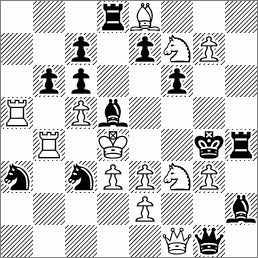
| 35.consecutive checks | | 13 + 13 |
Show Solution1. g8=Q+ Kf5+ 2. g4+ Qxg4+ 3. e4+ Bxe4+ 4. Bd7+ Rxd7+ 5. Sd6+ Rxd6+ 6. Qd5+ Bxd5+ 7. e4+ Qxe4+ 8. dxe4+ Bxe4+ 9. cxd6+ Sab5+ 10. Rbxb5+ c5+ 11. Rxc5+ e5+ 12. Rxe5+ fxe5+ 13. Sxe5+ Bf3+ 14. Sg4+ Sb5+ 15. Qxb5+ c5+ 16. Qxc5+ bxc5+ 17. Rxc5+ Be5+ 18. Rxe5+
Imants J. Ķīsis (14-02-1929 - 13-09-1993) Latvian composer and FIDE Master
Ķīsis composed a
problem achieving the Urania theme, but for now we prefer the following two problems, which were selected in the FIDE Album:
Ķīsis, Imants J.
Шахматы в СССР 1974
1
st Prize
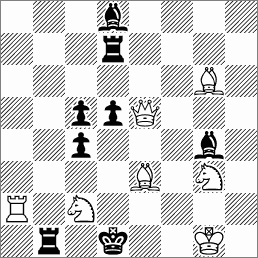
Show SolutionTries:
1.Bh5[A]? (2.Bxg4#) but 1...Rb2!
1.Ra1[C]? (2.Rxb1#) but 1...Bf5!
1.Qa1[D]? (2.Qxb1#) but 1...Rb7!
1.Qh5[B]! (2.Qxg4#)
1...Bxh5[a] 2.Bxh5#[A]
1...Bf3[c] 2.Qxf3#[J]
1...Be2[d] 2.Qxe2#[G]
1...Rf7 2.Qxd5#
Diagonal-orthogonal correspondence in tries and solution.
Ķīsis, Imants J.
Magyar Sakkélet, 1974
3
rd Prize
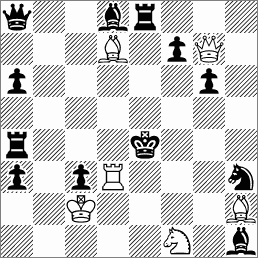
Show SolutionSet play:
1...Qd5[a] 2.Re3#[B]
1...Be7/Re5[b]/Rf8[c]/Rg8[c]/Rh8 2.Qe5#[A]
1...Ra5[d]/Rd4[e] 2.Qd4#[C]
1...Sf4[f] 2.Sg3#[D]
1.Bd6? (2.Sg3#[D])
1...Re5[b] 2.Qxe5#[A]
1...Rd4[e] 2.Qxd4#[C]
but 1...Bh4!
1.Qxf7! (2.Qxg6#)
1...Qd5[a] 2.Qxd5#[E]
1...Re5[b] 2.Sg3#[D]
1...Re6/Rf8[c]/Rg8[c] 2.Qxe6#[G]
1...Ra5[d] 2.Qc4#[F]
1...Rd4[e] 2.Re3#[B]
1...Sf4[f] 2.Qxf4#[H]
1...Qc6 2.Bxc6#
Ideal
Rukhlis.
Stocchi.
Josef Weisel (14-02-1939) Israeli composer
Josef Weisel has
a s#4 published in the FIDE Album
Weisel, Josef
problem (Zagreb) 1960
1
st Prize
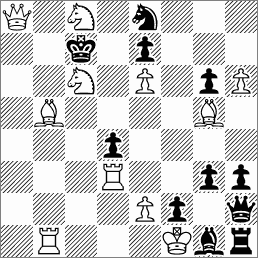
Show Solution1.Rc1 ! ZZ
1...Sf6 2.Sxe7+ Kd8 3.Sd5 Qg2/g2#
1...Sd6 2.Sxd4+ Kd8/Sc4 3.Sf3 Qg2/g2#
Surprising pinnings of the black S on 2 different lines.






Frangen's retro appears to have been anticipated (with an improved version) by Bror Larsson, Tidskrift for Schack, 1940: k1K5/q2R4/1P6/P7/8/8/8/8, #1. See: http://www.softdecc.com/pdb/search.pdb?expression=PROBID='P1012943'&s=0
ReplyDelete